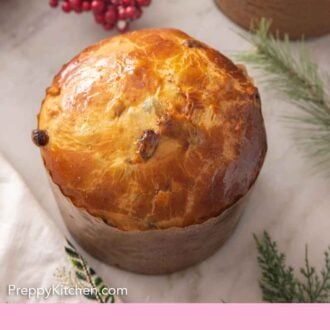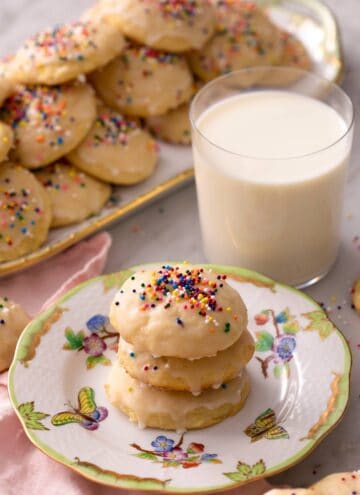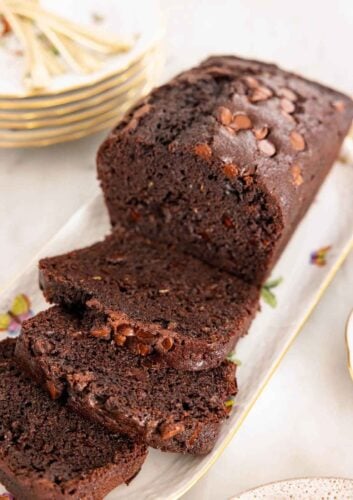Panettone is a sweet Italian bread originally from Milan. It is usually made around Christmas and New Year as a “luxury cake” as yeast was considered a special ingredient during the 15th century. Now, you’ll see mass-produced panettone sold in-stores during the holidays. However, I think there’s nothing more delicious than a homemade loaf of panettone fresh out of the oven. Plus, the whole house will smell of freshly baked bread. It’s a straightforward dough to work with, but this bread does take some time to make as there’s a long rise time, so be sure to plan ahead. For more delicious bread recipes, try my popover recipe, homemade monkey bread, and cranberry orange bread.
What You Need to Make This Recipe
Fillings — panettone is traditionally filled with candied oranges, raisins, and zest.
Rum — not only does soaking the raisins in rum help make them plump, soaking the fillings with rum helps prevent the bread from being dry. If you skip rehydrating the fruit, it can dry out the surrounding dough by absorbing moisture.
Active dry yeast — make sure the yeast you have on hand has not expired. It’s always best to purchase a fresh packet to ensure your panettone comes out fluffy.
Flour — I recommend using high-quality flour such as King Arthur for this panettone recipe. Using strong and gluten-rich flour helps the bread hold up the soaked fruit.
How to Make Panettone
1. In bowl, combine warm water and yeast. Let stand until the yeast is dissolved. Add the flour and mix until well combined. Cover and let rise for at least 8 hours and up to 12 hours to make the starter.
2. In a small bowl, stir together the raisins, candied orange peel, rum, and hot water. Cover and let soak for 8 hours or up to 2 days.
3. Once the starter is very bubbly, stir together warm water and the rest of the yeast and let stand until foamy, about 5 minutes.
4. Combine the starter and the flour, sugar, butter, 3 eggs, vanilla, and salt. Using the dough hook attachment on your stand mixer, mix at low speed until ingredients are combined. Add the orange zest and continue mixing until a smooth dough is formed. Cover the mixing bowl and let rise in a warm place until doubled in size, about 2 to 3 hours.
5. Once the dough has risen, drain the fruit and add them along with the slivered almonds to the dough. Mix on low speed until the fruit and nuts are well dispersed in the dough.
6. Transfer the dough to a well-floured surface and knead a few times to shape it into a ball. Cut the dough in half and shape each half into a ball, flouring the dough and your hands as needed.
7. Place one dough ball in each of the panettone molds. Cover loosely with a damp tea towel or plastic wrap and let rise until the dough just comes above the rim of the mold, about 3 hours.
8. Beat the remaining egg and lightly brush over the top of the risen dough. Place the baking sheet in the oven. Bake for 40 minutes or until the top is golden brown and a toothpick inserted into the center comes out clean, covering loosely with foil if the top is getting dark brown quickly. Let your panettone cool completely on a wire rack.
Pro Tips for Making This Recipe
- Though panettone is typically made with candied citrus and raisins, you can use any of your favorite dried or candied fruits.
- Panettone is traditionally a sourdough-based or long-ferment bread. My panettone bread recipe uses store-bought yeast for easy baking but keeps some of the longer rise times. While you might need a little planning, your patience will be rewarded! The overnight sponge and long rise times create a bread with a deeper, more complex flavor.
- Avoid adding too much flour by measuring your flour correctly! Adding too much flour to the recipe is the most common mistake and will make your bread dense. The best way to measure flour is by using a kitchen scale.
- The warm water and sugar help activate the yeast. If the water is hot, it can kill the yeast, and if it’s not warm enough, the yeast won’t activate. Aim to have the water around 110 to 120F for the best results.
- To be evenly and quickly incorporated into the dough, the eggs should be at room temperature. This prevents the dough from being over-mixed. If you forgot to set out your eggs, you could quickly bring them to room temperature by placing them in a large bowl and covering them with warm tap water for 5 minutes.
- Do not rush the rising time as it’s is essential for gluten development and flavor. The ideal temperature for the dough is 75 to 78F. If you have a cold kitchen, place the panettone molds with the dough in an off oven with the oven light on.
Frequently Asked Questions
Is this bread or cake?
Panettone is a yeast-based sweet dough, so it is bread. However, the crumb is similar to a cake as it’s buttery and cake-like. It is intended to be eaten as a treat like a cake and is also called a panettone cake, so it is a little ambiguous.
How do I store leftovers?
Keep the panettone in the paper molds and tightly wrapped in plastic wrap for up to 2 weeks. Feel free to serve it at room temperature or lightly reheated in the oven.
Can I freeze this?
To freeze panettone, wrap it tightly in plastic wrap and then tin foil, and freeze it for 2 to 3 months. Freeze the bread whole or in slices. Bring the bread to room temperature by leaving it on the counter or slowly thaw in the refrigerator overnight when ready to enjoy.
How do I serve this bread?
You can serve the panettone bread by itself or spread some softened butter, honey butter, or a drizzle of honey. As this is also considered an Italian Christmas bread, a bubbly wine to celebrate Christmas pairs well with the bread as well.
If you’ve tried this Panettone recipe, then don’t forget to rate the recipe and let me know how you got on in the comments below, I love hearing from you!

Panettone
Equipment
- Stand mixer
- Large bowl
- Panettone molds
- Baking Sheet
Ingredients
For the Soaked Fruit:
- 1¼ cup raisins
- ¾ cup chopped candied orange or lemon peel
- ¼ cup rum
- ¼ cup hot water
For the Starter:
- ½ cup warm water
- ¼ teaspoon active dry yeast part of a .25-ounce packet
- 1 cup plus 2 tablespoons all-purpose flour (135g)
For the Dough:
- ⅓ cup warm water
- 2 teaspoons active dry yeast remaining part of a .25-ounce packet
- 4 cups all-purpose flour (480g)
- ¾ cup granulated sugar (150g)
- ½ cup unsalted butter melted (113g)
- 4 large eggs room temperature and divided
- 1 tablespoon vanilla extract
- 1¼ teaspoon salt
- Zest of 1 orange
- ½ cup slivered almonds
Instructions
For the Soaked Fruit:
- In a small bowl, stir together the raisins, candied orange peel, rum, and hot water. Cover and let soak for 8 hours or up to 2 days.
For the Sponge:
- In the bowl of a stand mixer, combine warm water and yeast. Let stand until the yeast is dissolved. Add the flour and mix until well combined. Cover and let rise for at least 8 hours and up to 12 hours.
For the Dough:
- Once the sponge is very bubbly, stir together warm water and yeast and let stand until foamy, about 5 minutes.
- Add it to the starter along with the flour, sugar, butter, 3 eggs, vanilla, and salt. Using the dough hook attachment, mix on low speed until ingredients are combined. Add the orange zest and continue mixing until a smooth dough is formed, about 15 minutes. (The dough should be mostly pulling away from the sides of the bowl. If it doesn’t after 12 minutes add another tablespoon or two of flour.) Scrape the dough down into the bottom of the bowl and cover. Let rise in a warm place until doubled in size, about 2 to 3 hours.
- Meanwhile, drain any remaining liquid from the soaked fruit. Place two 9x13cm panettone molds on a baking sheet.
- Once the dough is risen, return the dough bowl to the stand mixer with the dough hook attachment. Add the drained fruit and slivered almonds. Mix on low speed until the fruit and nuts are well dispersed in the dough, about 1 to 2 minute. (The dough will become very sticky.)
- Transfer the dough to a well floured surface. Sprinkle the dough with flour and knead a few times to shape into a ball. Cut the dough in half and shape each half into a ball, flouring the dough and your hands as needed. Place one dough ball in each of the panettone molds. Cover loosely with a damp tea towel or plastic wrap and let rise until the dough just comes above the rim of the mold, about 3 hours.
- When the bread is almost done rising, preheat the oven to 400F.
- Beat the remaining egg and lightly brush over the top of the risen dough. Place the baking sheet in the oven. Immediately reduce the oven temperature to 350F.
- Bake for 40 minutes or until the top is golden brown and a toothpick inserted into the center comes out clean, covering loosely with foil half through if the top is getting dark brown quickly. (It should also sound hollow when tapped.) Let cool completely on a wire rack. Keep the panettone in the paper molds and tightly wrapped in plastic wrap until ready to serve, or up to 2 weeks. Gently peel the paper off the sides before slicing.
Notes
- Though typically made with candied citrus and raisins, you can use any of your favorite dried or candied fruits.
- Panettone is traditionally a sourdough-based or long-ferment bread. My panettone bread recipe used store-bought yeast for easy baking but keeps some of the longer rise times. While you might need a little planning, your patience will be rewarded! The overnight sponge and long rise times create a bread with a deeper, more complex flavor.
- Avoid adding too much flour by measuring your flour correctly! Adding too much flour to the recipe is the most common mistake and will make your bread dense. The best way to measure flour is by using a scale. If you don’t have one, then fluff your flour with a spoon, sprinkle it into your measuring cup, and use a knife to level it off.
- The warm water and sugar help activate the yeast. If the water is hot, it can kill the yeast, and if it’s not warm enough, the yeast won’t activate. Aim to have the water around 110 to 120F for the best results.
- To be evenly and quickly incorporated into the dough, the eggs should be at room temperature. This prevents the dough from being over-mixed. If you forgot to set out your eggs, you could quickly bring them to room temperature by placing them in a large bowl and covering them with warm tap water for 5 minutes.
- Do not rush the rising time as it’s is essential for gluten development and flavor. The ideal temperature for the dough is 75 to 78F. If you have a cold kitchen, place the panettone molds with the dough in an off oven with the oven light on.

























Leave a Reply